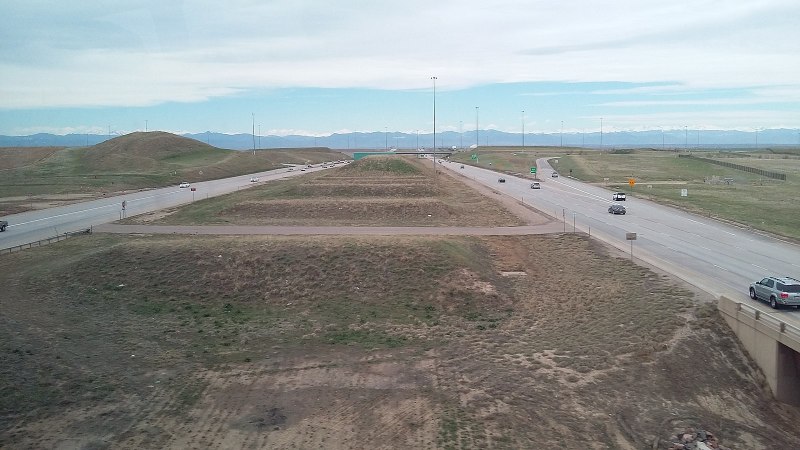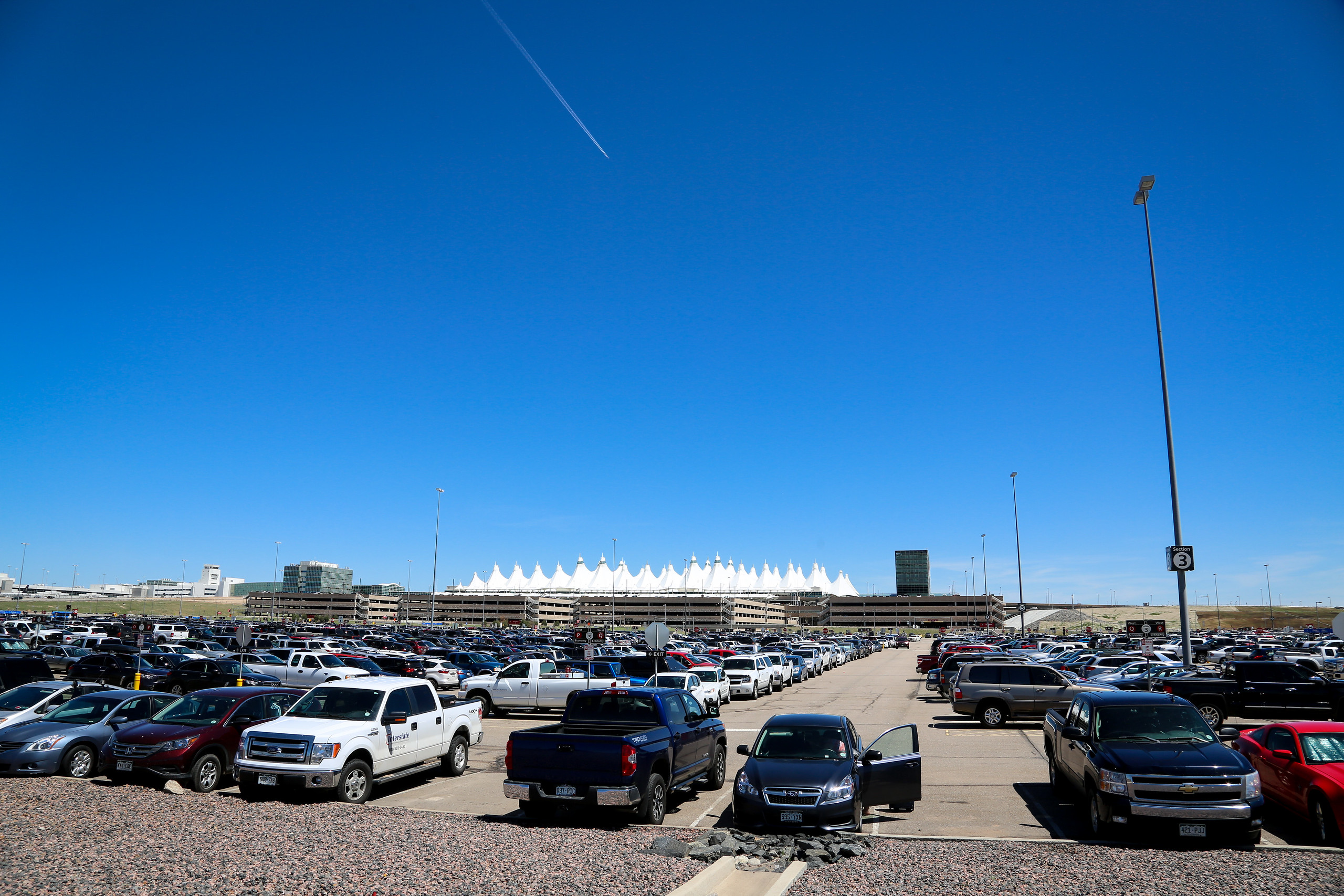Update: Council Approves Denver Airport Road Widening That Would Make Traffic Worse

Update: Monday night the Denver City Council approved this project in an 11-1 vote. Read more at the Denver Post, Denverite or Fox 31.
A plan to widen the road to Denver International Airport, which would make traffic worse and wipe out the city’s newly-minted goals to cut greenhouse gas emissions, will get a vote from the Denver City Council on Monday. The $94 million project would expand part of Peña Boulevard from six to nine lanes and be the first of four phases in a 10-year road expansion program that could total more than $1 billion.
“There are a set of things that seem like reasonable investments to make the airport more functional,” said Danny Katz of CoPRIG, which is a part of the Denver Streets Partnership, a coalition of mobility advocates. “But my concern is that this is the first phase to a traditional road widening project, and we know that does not work in terms of moving people effectively and smoothly.”
Expanding multi-lane urban roads and highways can reduce traffic, but only for a few years before new congestion exceeds earlier levels. The phenomenon, known as induced demand, played out in Denver after the $1.6 billion T-REX expansion of I-25 where traffic worsened in a matter of years after completion.
The Peña project would use airport funds, but the city owns the airport and recently set a goal to cut the number of people who travel alone in cars. The airport did not design the project to align with Denver’s new mobility targets.
“At the end of the day, we need a goal to reduce single occupancy vehicles,” said Katz. “And then work from that goal, using trains, buses, shuttles and ride share so we’re not just adding more cars to the region.”
The city’s new mobility goals are a part of Denveright, a sweeping set of plans the council approved just three months ago. They set a target to reduce the number of people who drive alone in the city, from 73 percent of trips today to 50 percent by 2030. If met, the goal would reduce traffic congestion, diminish air pollution and lower emissions that contribute to the climate crisis. Denveright calls for an 80 percent reduction in greenhouse gas emissions by 2050.

The city will wipe out those goals if it makes it easier to get to the airport by car. But District 11 Councilwoman Stacie Gilmore, whose district includes the airport and surrounding neighborhoods, said in an interview that she will vote for the first phase of the project, in part because she says the road is congested, it needs upgrades after 24 years of use and the airport would gain a designated bus lane.
“There is going to be increased lane capacity, but that’s only 6.4 percent of the project,” she said. “That will allow us to have a designated bus lane to help us get those SOV trips off the roadway.”
The first phase of the project came up for a vote at Monday’s council meeting when Raphael Espinoza, an outgoing councilmember, pushed it to next week so that incoming councilmembers could have a say. But he raised a number of questions, including whether the amount of traffic on Peña justifies the expansion.
“When does it get bumper to bumper?” he asked at the meeting.
But Gilmore said on a phone call that she regularly hears of traffic congestion.
“I have plenty of emails from individuals,” she said. “Or if you go on Nextdoor or Facebook, you will see pictures of bumper to bumper traffic on Peña, especially for early morning travelers.”

She also expressed skepticism that her constituents who drive work trucks or run food trucks would be willing to switch to public transportation. Other residents may balk the $10.50 fare to take the A Line to DIA.
“How would we incentivize individuals to not drive to the airport?” she asked. “What are the mechanisms that folks are thinking to do that? How can we have those conversations?”
But mobility advocates say those conversations should happen before approving the project. Unlike the work that went into the Denveright plans, which included extensive public comments over several years, transportation advocates only learned of the Peña Boulevard widening June 19 and were not included in discussions before it was sent to the full council for a vote.
“There needs to be way more transparency whenever DIA is spending money on moving people to or from the airport,” said Katz. “They’re not just making decisions about their property. They really are a connector to the whole region, we are all impacted by it.”
The success of the Regional Transportation District’s A Line train to the airport, which exceeded ridership expectations with 7 million boardings in 2018 and required expanding two-car trains to four cars earlier this year, demonstrates another example of induced demand: When people have good alternatives to driving, they will take them.

But airport officials seem to think they’ve done enough for public transportation. DIA spent $350 million on a transit hub, which opened in 2016 to accommodate busses and the A Line. They also paid more than $30 million toward the 61st and Peña station.
“In the past five years, we have spent $400 million on transit,” said Rachel Marion, director of government affairs for DIA. “Which to our knowledge, is more than any other entity in the state of Colorado outside of RTD and maybe CDOT.”
But RTD says the A Line could be expanded. Some segments of the line have just one track, which limits its frequency to four trains per hour in each direction. But stations could be adapted to accommodate longer trains.
“The station platforms can be built out to increase train length from four to eight cars each,” said Laurie Huff, a spokesperson for RTD, in an email. “The track alignment and geometry were designed and constructed to allow for future expansion.”
Airport officials are eager to push the project through now after resolving a battle with the Federal Aviation Administration that started in 2010.
“The FAA wrote a letter that the airport can no longer pay for Peña Boulevard,” said George Merritt, the head of government affairs for the airport.
As commercial and residential development went up along Peña, local traffic on the road increased and airports are not allowed to pay for improvements that do not directly benefit their passengers. But the FAA and DIA reached a compromise in 2017 which allows the airport to pay for the first phase of the project in its entirety, and 75 percent of the future phases.
The four phases of the Peña widening could cost $400 million for the entire 12-mile project, but the project study lists several scenarios that would exceed $1 billion.
Independent journalism needs support. Give $10 now.



